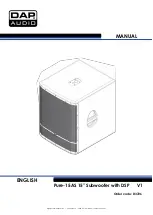
www.dbtechnologies.com
info@dbtechnologies
‐
aeb.com
VIO
S218
420120267Q
REV.1.1
3) First switch on
The 2 DIGIPRO G4 amplifiers of VIO S218 are controlled
by a powerful DSP. All the connections and controls are
in the rear amplifier control panel:
1 – Input (balanced) connector
2 – Link (balanced) connector
3 – Subwoofer attenuation rotary control
4 – Status LEDs (Limiter, Signal, Mute/Protection,
Ready)
5 – Polarity switch
6 – Delay rotary controls
7 – Cardioid preset switch
8 – HPF Xover (balanced) output
9 – Xover rotary control
10 – RDNet Data In
11 – RDNet Data Out
12 – RDNet status LEDs
13 – USB Data Service
14 – Test momentary switch
15 – Full range Mains input connector
16 – Mains Link connector
17 – Mains Fuses
The subwoofer is supplied with two mounted fuses for
operation within the 220-240V~ range. If you need to
operate in the 100-120V~ voltage range:
Disconnect all connections, including the power
supply
Wait 5 minutes
Replace the fuses with the ones provided in the
package for the 100-120V~ range
a)
Once you have properly set up the desired
configuration (see also the VIO S218 complete user
manual and accessories instructions for further
information), connect the audio input (
1
). Set the
Subwoofer attenuation (
3
) to the desired level.
b) Connect the possible output direct link (
2
), and/or
HPF Xover output (
8
). Set the Xover rotary control (
9
)
to the correct frequency. This filter acts on internal
transducers and on HPF Xover output (
8
), It does not
affect the link output (
2
).
c) Choose the Subwoofer Setup (Polarity and Delay
5,
6
) to obtain the correct behavior. In cardioid
configuration, please note that the cardioid preset
switch (
7
), when active, bypass Polarity and Delay
controls.
d)
In case of remote control, connect the Data Input
(
10
) to the hardware remote controller (RDNet Control
2 or RDNet Control 8) with cables equipped with
etherCON connectors. Then connect the Data Output
(
11
) to the Data Input (
10
) of a possible second device,
and so on. When the RDNet network is on and it has
recognized the connected device, the LED “Link” (
12
) is
on. The other LEDs (
12
) “Active” start blinking at the
presence of data transmission, the “Remote Preset
Active” advise that all the local controls set on the
amplifier panel (level, DSP presets, etc.) are by-passed
and controlled remotely by RDNet.
In remote control it is essential the use of free
dBTechnologies software:
dBTechnologies AURORA NET,
necessary for an in-depth control of different devices
in remote connection;
dBTechnologies Composer,
necessary for the mechanical safety check in
installation and for the complete sound system design,
particularly developed for VIO series.
e)
Connect the power supply (
15
). It is possible to link
up to 1 VIO S218** at 220V-240V with the related
mains link connector (
16
) (see Technical Data for
further information).
Check the complete user manual on
www.dbtechnologies.com
for further
information about the system and available accessories.
Scarica il manuale completo da
www.dbtechnologies.com
per ogni
ulteriore informazione sul sistema e sugli accessori disponibili.
Für weitere Informationen und verfügbares Zubehör lesen sie bitte die
vollständige Bedienungsanleitung unter
www.dbtechnologies.de
.
Vérifiez le manuel de l'utilisateur complet sur
www.dbtechnologies.com
pour des informations complémentaires du système et des accessoires
disponibles.
Compruebe el manual de usuario completo sobre
www.dbtechnologies.com
para la información adicional sobre el sistema
y accesorios disponibles.
The product and accessories must be handled
by trained personnel only!
The user is
required to follow regulations and mandatory
laws on safety of the country in which the product is
used.
Don’t use handles and/or roping points to hang
VIO S218!






















